Case Studies
Case 1. Pamela
Pamela, a 12-year-old F(s) Bichon Frise dog, was presented for a 1-week history of small bowel diarrhea, decreased appetite, and decreased activity.
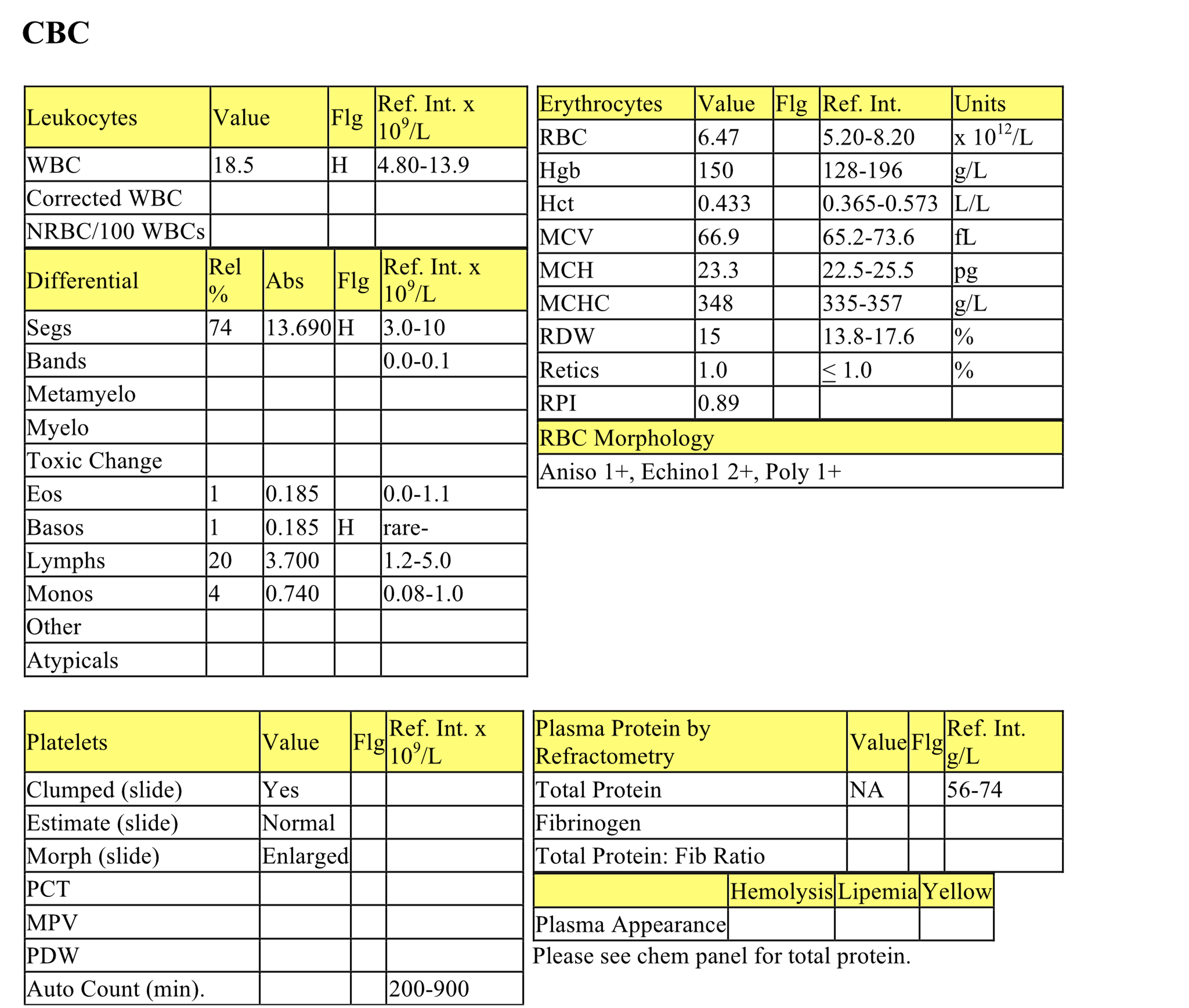
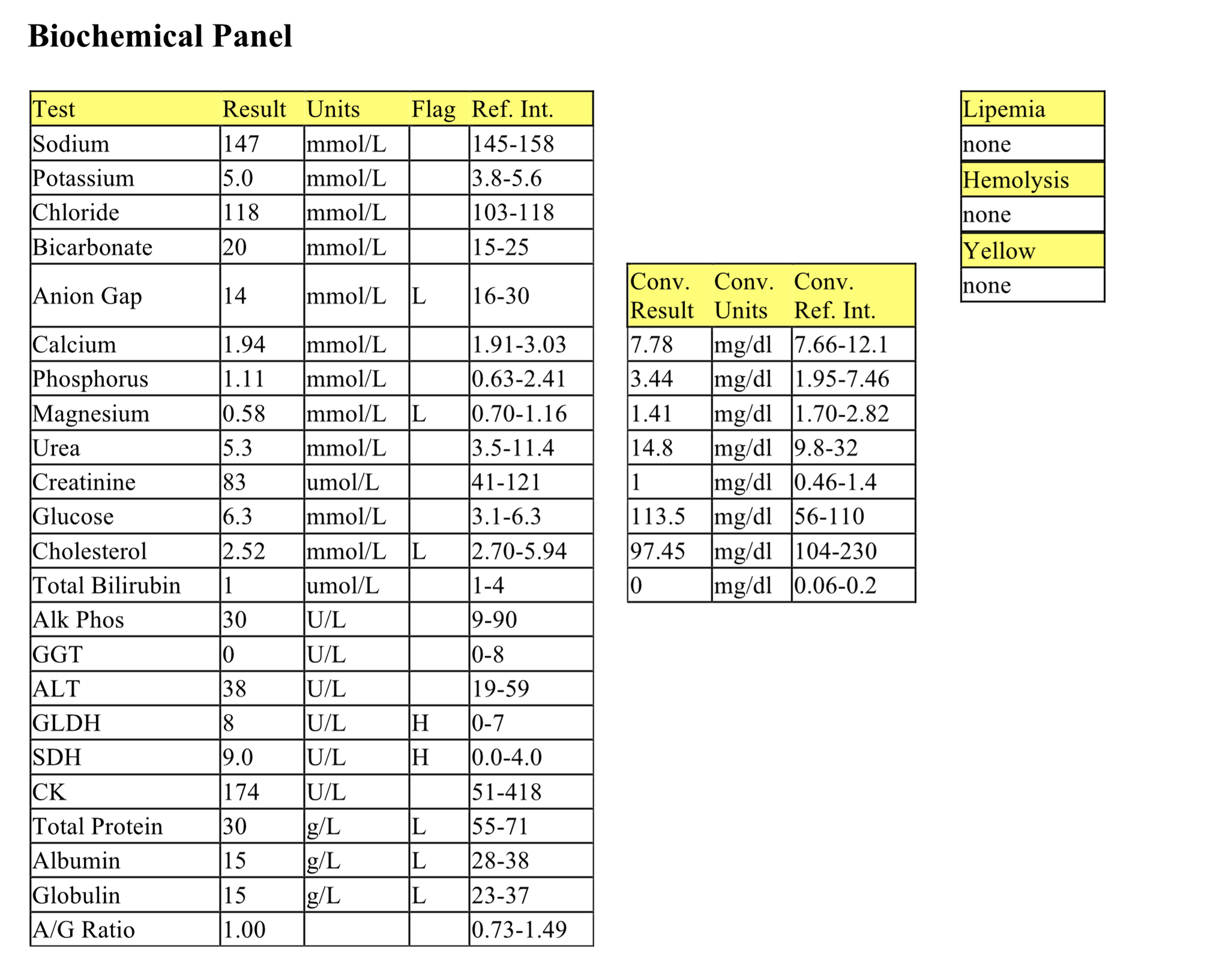
CBC
Polychromasia noted on smear evaluation may not be significant since the hematocrit is within the RI and reticulocytes are not increased, however it may reflect resolving hemorrhage, hemolysis or hypoxia. There is a mild leukocytosis characterized by mild neutrophilia which may indicate inflammation. The lack of stress lymphopenia could be significant if Pamela is clinically quite ill. Very mild basophilia is unlikely to be clinically significant.
Biochemical Panel
Low anion gap relates to hypoalbuminemia (decreased “unmeasured” anion). Mild hypomagnesemia may be due to low albumin since 30% of magnesium is bound to albumin; there may also be contributions from decreased intake. Mild hypocholesterolemia suggests decreased absorption from the bowel or decreased hepatic synthesis. Mild increases in GLDH and SDH activities may indicate mild hepatocellular injury, although the significance is questionable given the lack of ALT increase. The most important finding on the biochemical panel is the marked panhypoproteinemia (both albumin and globulins are decreased equally). Protein losing enteropathy is likely, particularly given the history of diarrhea. Hepatic failure occasionally results in panhypoproteinemia, although albumin synthesis is usually affected to a greater extent than globulin synthesis.
- Fine needle aspirates of 3 regions of intestinal wall were non-diagnostic. Pamela underwent surgery to obtain intestinal biopsies. The final histologic diagnoses were: lymphangiectasia; enteritis: plasmacytic, eosinophilic, diffuse, moderate to severe; and ileitis: neutrophilic, diffuse, mild. Pamela was treated with oral corticosteroids and diet management and has shown great improvement with only occasional bouts of diarrhea.
Case 2. Josie
Josie, a 10-month old F German Shepherd dog, had a history of weight loss for 3 weeks despite a good appetite. She had malodorous, voluminous stools.
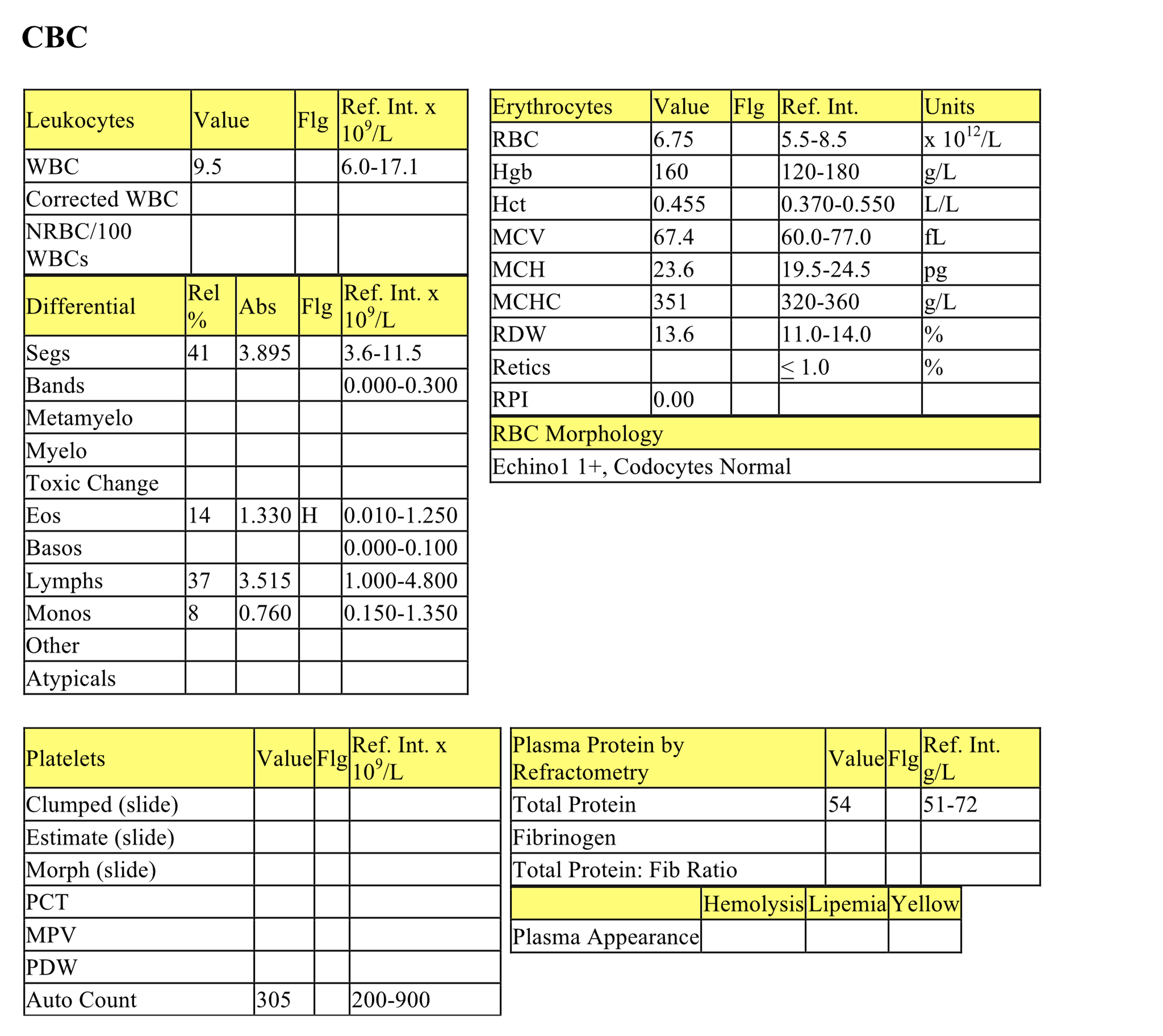
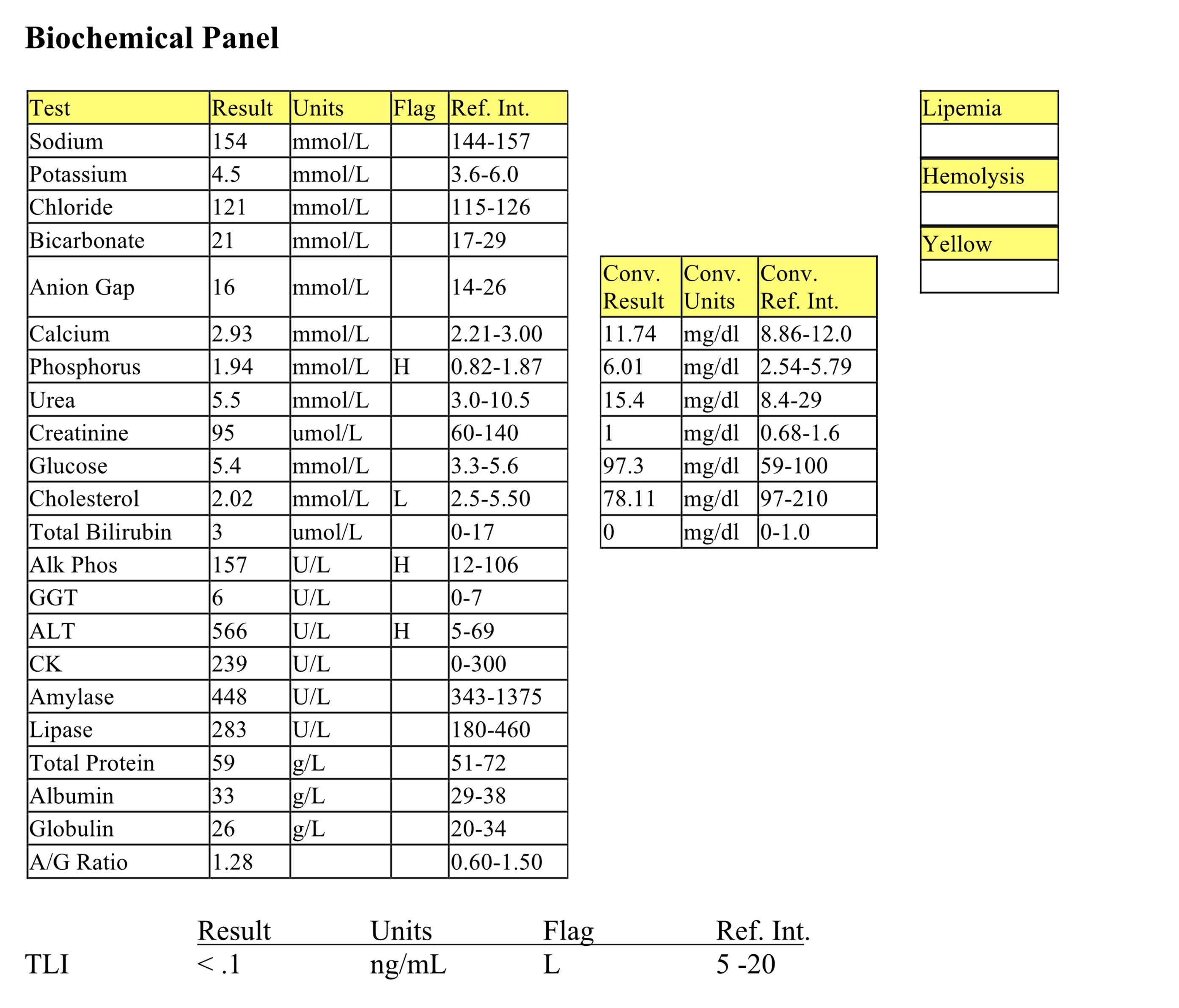
CBC
The erythrogram is unremarkable. The leukogram is also generally unremarkable with the exception of mild eosinophilia which could be due to parasitism or allergy or normal fluctuation for this dog. Josie was not clinically ill, so the lack of lymphopenia and eosinopenia was not considered abnormal for the circumstances. Recent vaccinations can also increase lymphocyte numbers, thus masking a lymphopenia, especially in young animals.
Biochemical Panel
Mild hyperphosphatemia and increased ALP activity probably relate to bone growth in this young animal. Hypocholesterolemia can be associated with intestinal disorders and decreased fat absorption, as well as decreased hepatic synthesis. Moderately increased ALT activity indicates hepatocellular injury.
The history, breed, and clinical findings were highly suggestive of EPI, and TLI testing confirmed this diagnosis.
- The biochemical panel was repeated 1 week after pancreatic enzyme supplementation was begun. Cholesterol was then within the RI and ALT activity was only slightly above the RI. Josie had gained 2 kg. The association between increased ALT activity and EPI is not clear; however, this has been noted in other cases of EPI and activity declines with effective treatment. Bacterial overgrowth in the small bowel may accompany EPI and play a role in ALT release from hepatocytes.
Case 3. Sonia
Sonia, a 3-year-old Holstein-Friesian cow, had decreased milk production for 1 month, and recent anorexia, weakness, and watery diarrhea. She had undergone superovulation on several occasions since calving almost a year ago.
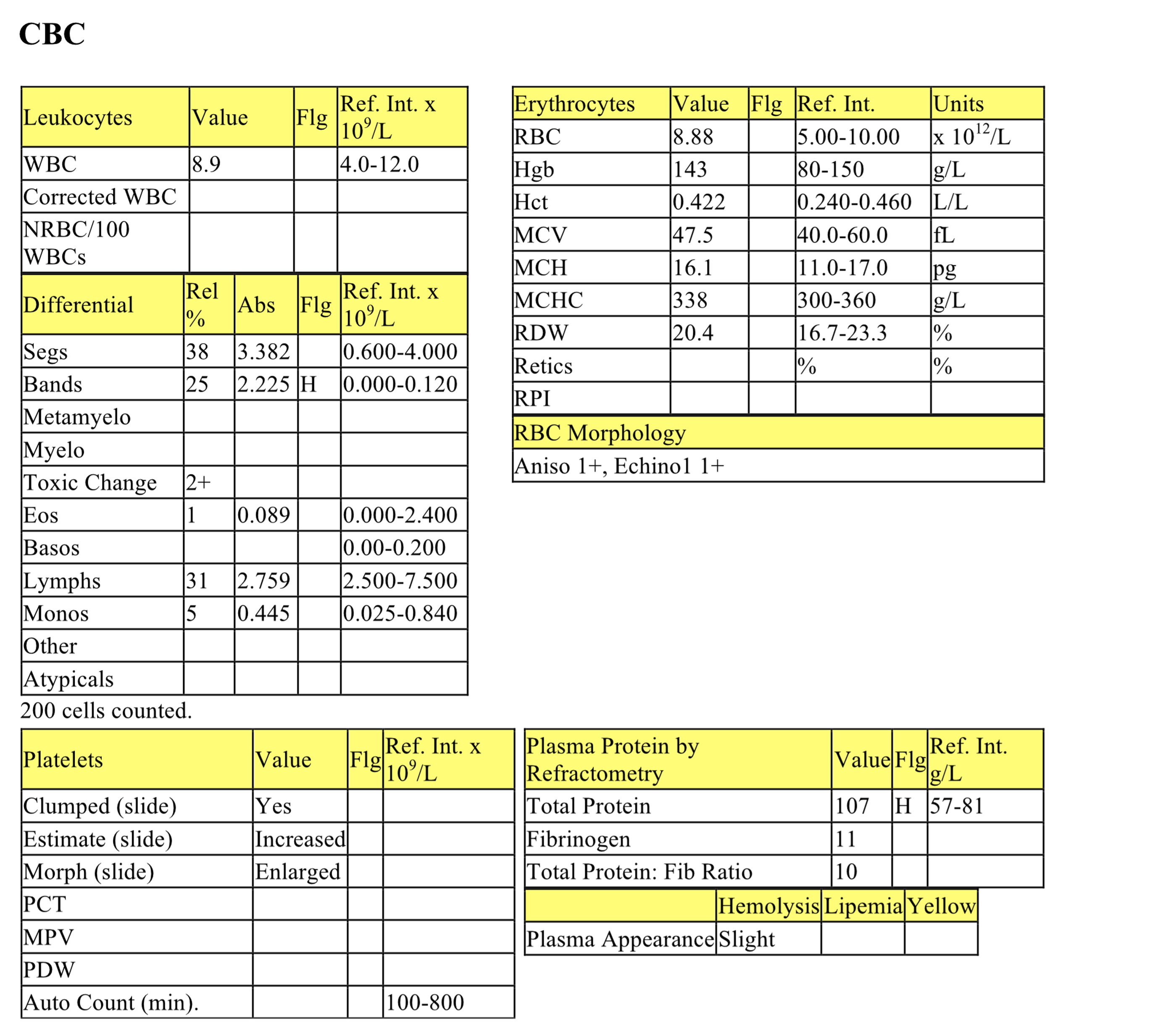

CBC
The erythrogram is unremarkable. Although the WBC count and mature neutrophil numbers are within RI, there is a moderate to severe left shift with toxic change indicating significant inflammation. Considering the low reserve of mature neutrophils in cattle, the inflammatory process may be established or in transition. That is, deterioration or improvement could occur quickly, emphasizing the value of monitoring the CBC closely in such circumstances. Lymphocyte numbers are low normal consistent with stress. Thrombocytosis may be reactive and related to the inflammatory process. Hyperproteinemia could be due to dehydration, hyperfibrinogenemia, or increased globulins (in any combination). The protein to fibrinogen ratio is in the “grey” zone, but absolute hyperfibrinogenemia is likely, particularly given the leukogram findings.
Biochemical Panel
Hyponatremia and hypochloremia probably relate to diarrhea and decreased intake. Chloride is disproportionately decreased compared to sodium consistent with loss or pooling in the abomasum that occurs with anorexia/inappetence in ruminants. The normal bicarbonate and increased anion gap indicate a mixed acid base disturbance – metabolic alkalosis from HCl pooling in the abomasum and metabolic acidosis from renal acid retention and possibly lactic acidosis. Urea and creatinine elevations indicate azotemia. Urinalysis is required to assess renal function, however, given the clinical evidence of dehydration, prerenal azotemia is possible. Mild to moderate hyperphosphatemia and hypermagnesemia are most likely due to decreased renal excretion. Mild hyperglycemia is likely stress-related. Mildly increased activities of CK and AST indicate muscle injury which could be due to transport to the clinic, handling and venipuncture, increased recumbency, or any combination thereof. Hyperproteinemia, mild hypoalbuminemia, and moderate hyperglobulinemia suggest increased globulin synthesis (acute phase proteins, gammaglobulins, or both), and decreased albumin synthesis (negative acute phase protein), increased albumin loss, or both. The albumin concentration may actually be lower since Sonia is dehydrated.
Abdominal Fluid
Increased nucleated cells and protein concentration are consistent with an exudate. Cytologic interpretation indicates non-septic, neutrophilic inflammation.
- Sonia was diagnosed with peritonitis and despite the lack of bacteria on cytologic examination of the abdominal fluid, antibiotic and fluid therapy were instituted. Sonia became progressively weaker and more recumbent. Urine was never obtained, but the azotemia was corrected with fluid therapy. Sonia underwent surgery and multiple adhesions of the intestines were found along with extensive peritonitis and enlarged mesenteric lymph nodes. Sonia was euthanized and submitted for necropsy. Necropsy findings included: acute and chronic, extensive, severe suppurative peritonitis; chronic multifocal lymphadenitis; acute, severe segmental necrotic enteritis; and sepsis. Trueperella pyogenes was cultured from abscessed lymph nodes.
Case 4. Petra
Petra, a 13-year-old F(s) Cocker Spaniel X dog, had a history of weight loss.
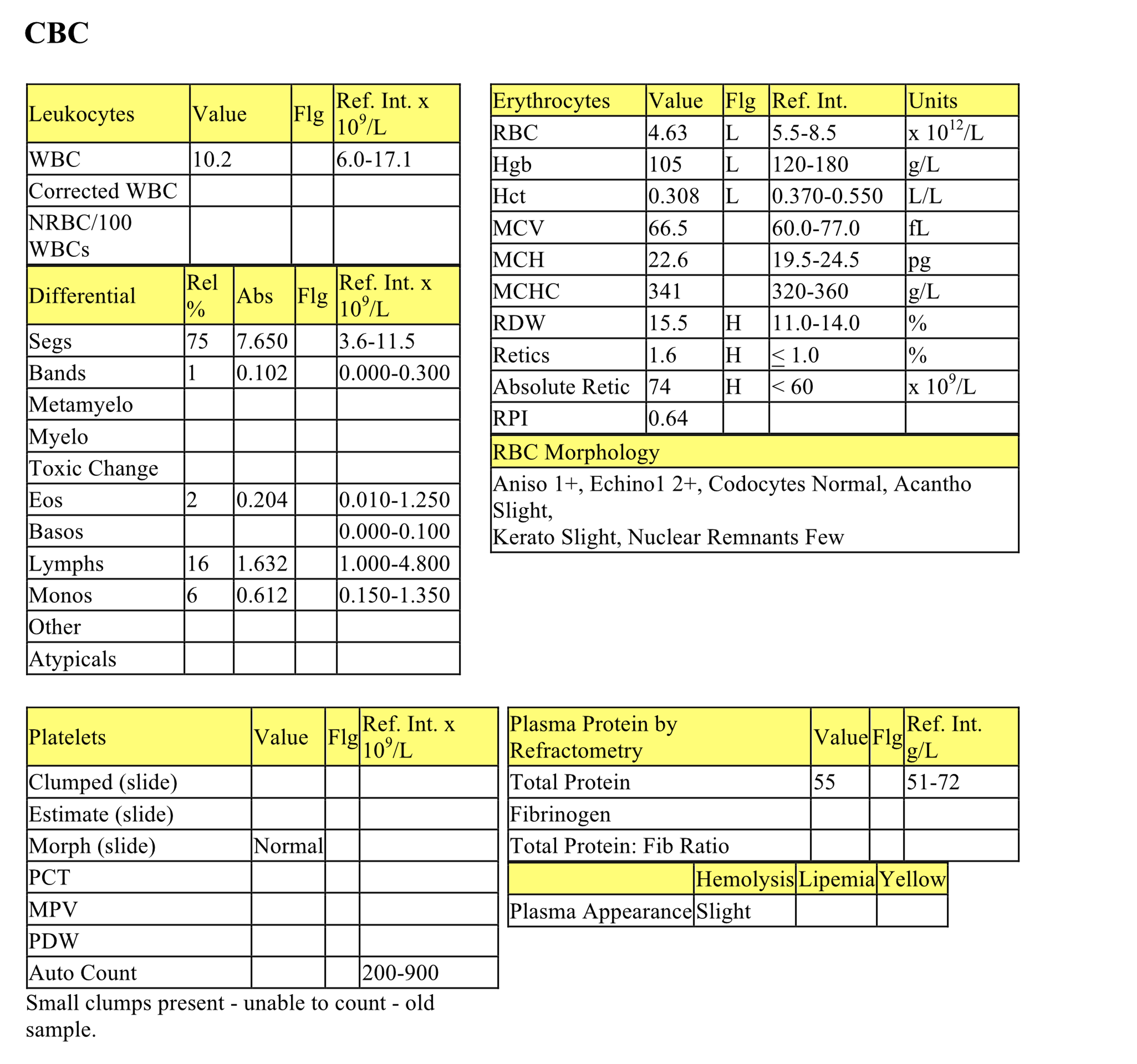
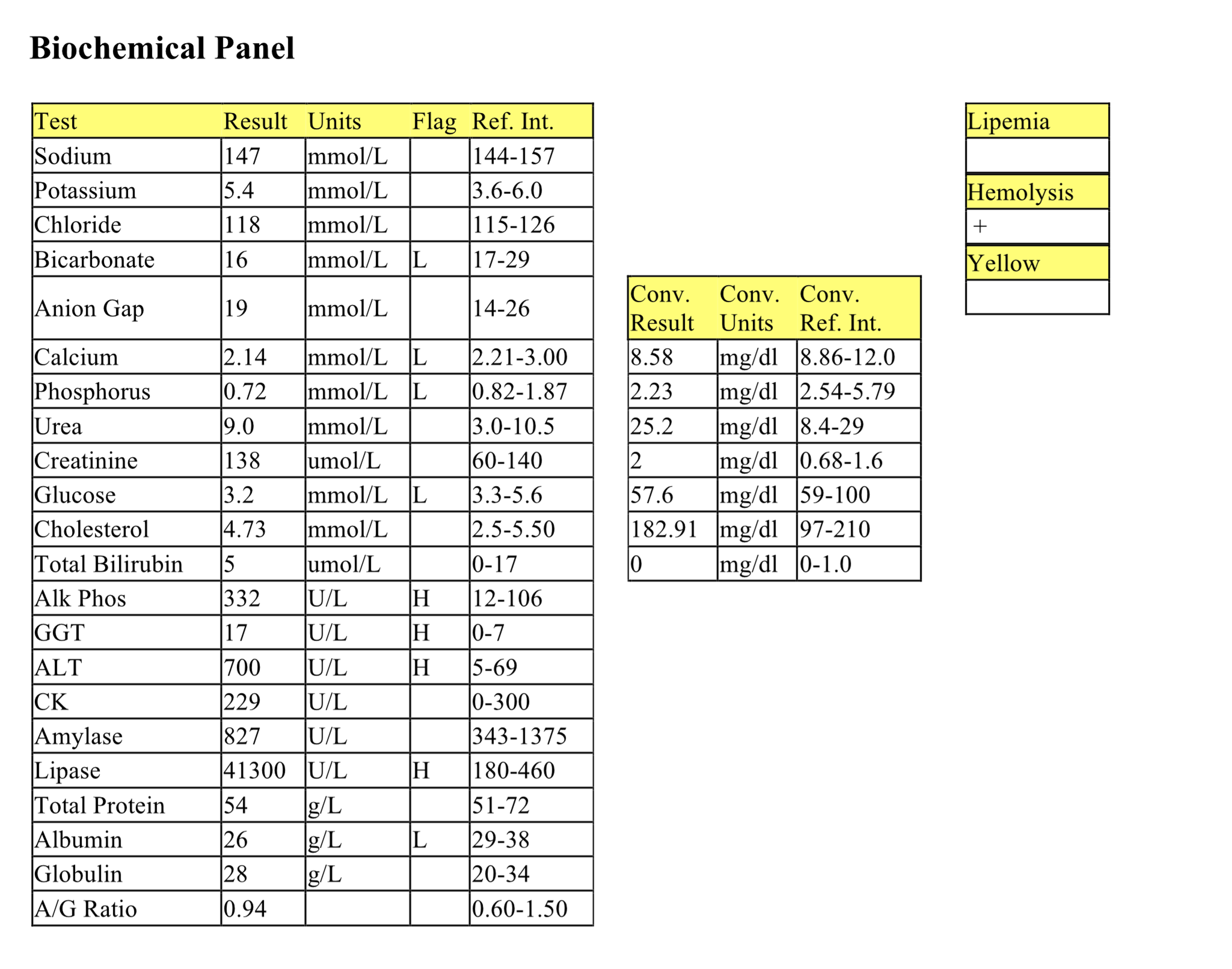
CBC
Mild/moderate nonregenerative anemia suggests anemia due to a serious underlying disease, given the history and lack of other potential causes identified on baseline laboratory tests. The significance of the slight red cell morphologic changes in this case is unclear. The leukogram is unremarkable.
Biochemical Panel
Mild metabolic acidosis without an increased anion gap suggests bicarbonate loss. Mild hypocalcemia relates to mild hypoalbuminemia; the mild hypophosphatemia could be due to decreased intake or related to diet. Mild hypoglycemia and hypoalbuminemia could be due to decreased hepatic synthesis (hepatic dysfunction). Increased production of insulin or an insulin-like protein (e.g. by a neoplasm) could also cause hypoglycemia. Increased activities of all hepatic enzymes suggest cholestasis and hepatocellular injury. Lipase activity is extremely increased, but amylase activity is within reference limits and the leukogram does not reflect inflammation, as would be expected with pancreatitis. The history is also not typical for acute or chronic pancreatitis. Abnormal production and release of lipase is suspected, e.g. secondary to neoplasia. Further investigation of the liver and pancreas is indicated.
- Imaging studies of the abdomen revealed mixed echogenicity of the liver and a mass caudal to the stomach. Petra was euthanized and tumor masses were found throughout the liver, omentum, and pancreas at necropsy. The histological diagnosis was endocrine carcinoma involving the liver, pancreas, omentum, diaphragm, and lymph nodes. Immunohistochemical staining for insulin, gastrin, glucagon, and neuroendocrine granules of a carcinoid tumor was negative. This case was later entered into a study of hyperlipasemia in dogs, and neoplastic tissue was found to express lipase antigen.
Case 5. Dirk
Dirk, an 8-year-old M(c) Labrador Retriever dog, had a history of eating garbage the day before presentation. He had been vomiting and lethargic since that time.

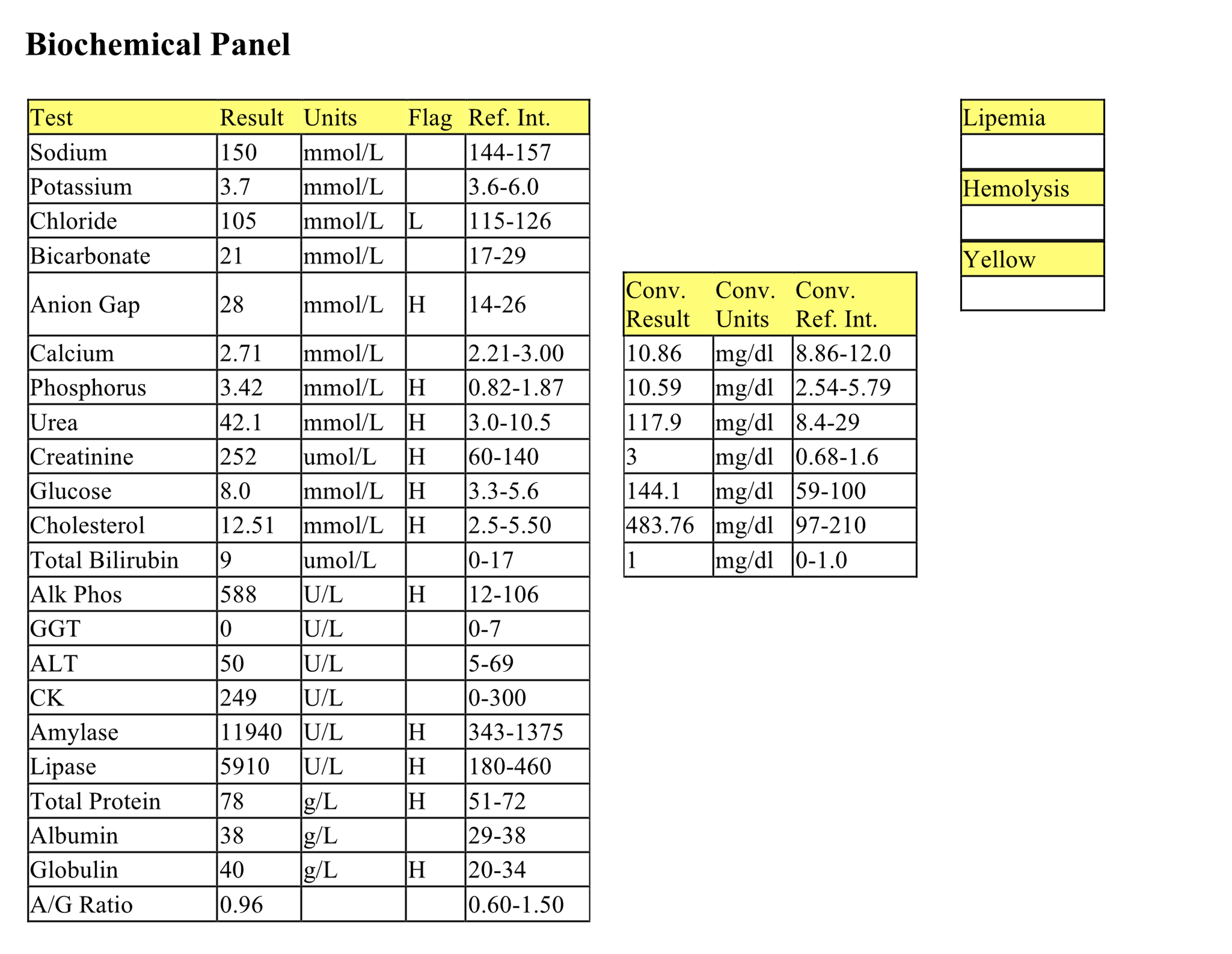
CBC
Mild erythrocytosis and moderate hyperproteinemia suggest dehydration. There is a mild leukocytosis characterized by a mild/moderate neutrophilia with a mild left shift, moderate monocytosis, and marked lymphopenia indicating significant inflammation and stress. Monocytosis suggests increased demand for phagocytic activity.
Biochemical Panel
Hypochloremia without hyponatremia is due to disproportionate loss of chloride secondary to vomiting and HCl loss. The normal bicarbonate and increased anion gap indicate the presence of both metabolic alkalosis (HCl loss) and metabolic acidosis (renal acid retention, lactic acidosis, or both). Urea and creatinine elevations may indicate prerenal azotemia given the presence of dehydration; however, urinalysis is recommended to assess urine concentrating ability. Moderate hyperphosphatemia is due to decreased renal excretion. Hyperglycemia is likely due to stress. Moderate hypercholesterolemia and increased ALP activity suggest cholestasis. Marked increases in activities of both amylase and lipase, together with the history and leukogram findings, support a diagnosis of pancreatitis. Hyperproteinemia with high normal albumin and mild hyperglobulinemia indicate dehydration.
- Pancreatitis was diagnosed. Pancreatic enzyme activities can be increased with renal disease, particularly when oliguric or anuric, but renal failure would not explain the leukogram findings in this case. Also, the azotemia is only moderate while the pancreatic enzyme changes are severe. Dirk was treated appropriately and although the pancreatitis resolved, he became increasingly icteric and ALP activity rose markedly. Local swelling of the bile duct or ascending cholangitis secondary to pancreatitis was suspected. After one month of care and monitoring, Dirk’s illness totally resolved.
Increased numbers of anucleate, immature erythrocytes that stain bluish-pink with Romanowsky stains due to the presence of cytoplasmic RNA.
Anucleate (in mammalian species), immature erythrocyte containing cytoplasmic RNA and ribosomes which are precipitated by staining with new methylene blue.
Erythrocyte rupture or destruction; may occur in vitro or in vivo as a pathologic process.
Increase in the number of basophils in peripheral blood.
Nonspecific term for sublethal or lethal injury to hepatocytes due to various causes, e.g. hypoxia, toxins, infection.
Concurrent decreased concentration of albumin and globulins.
Technique used to obtain samples for cytologic evaluation, using suction.
All tests on the complete blood count (CBC) that evaluate erythrocytes, including morphologic examination on the peripheral blood smear.
Increase in the number of eosinophils in peripheral blood.
Decrease in the number of eosinophils in peripheral blood. May not be detectable given the reference intervals.
Mononuclear, non-phagocytic leukocyte responsible for humoral (B lymphocyte) and cell-mediated (T lymphocyte) immune responses.
Lipid used to form cell membranes, steroid hormones, bile acids, and vitamin D.
Granulocyte with fine, inconspicuous cytoplasmic granules and a segmented nucleus; important in phagocytosis and killing of bacteria.
Cytoplasmic abnormalities seen in neutrophils that have not matured normally in the bone marrow. Abnormalities include retention of primary granules, vacuolation, darker staining due to retention of ribosomes, and deposits of rough endoplasmic reticulum (Döhle bodies).
Inflammation of the lymph node.
Malignant neoplasm of epithelial origin, e.g. squamous cell carcinoma.
Increase in hematocrit (PCV) in peripheral blood; usually accompanied by increases in hemoglobin and RBC numbers.

